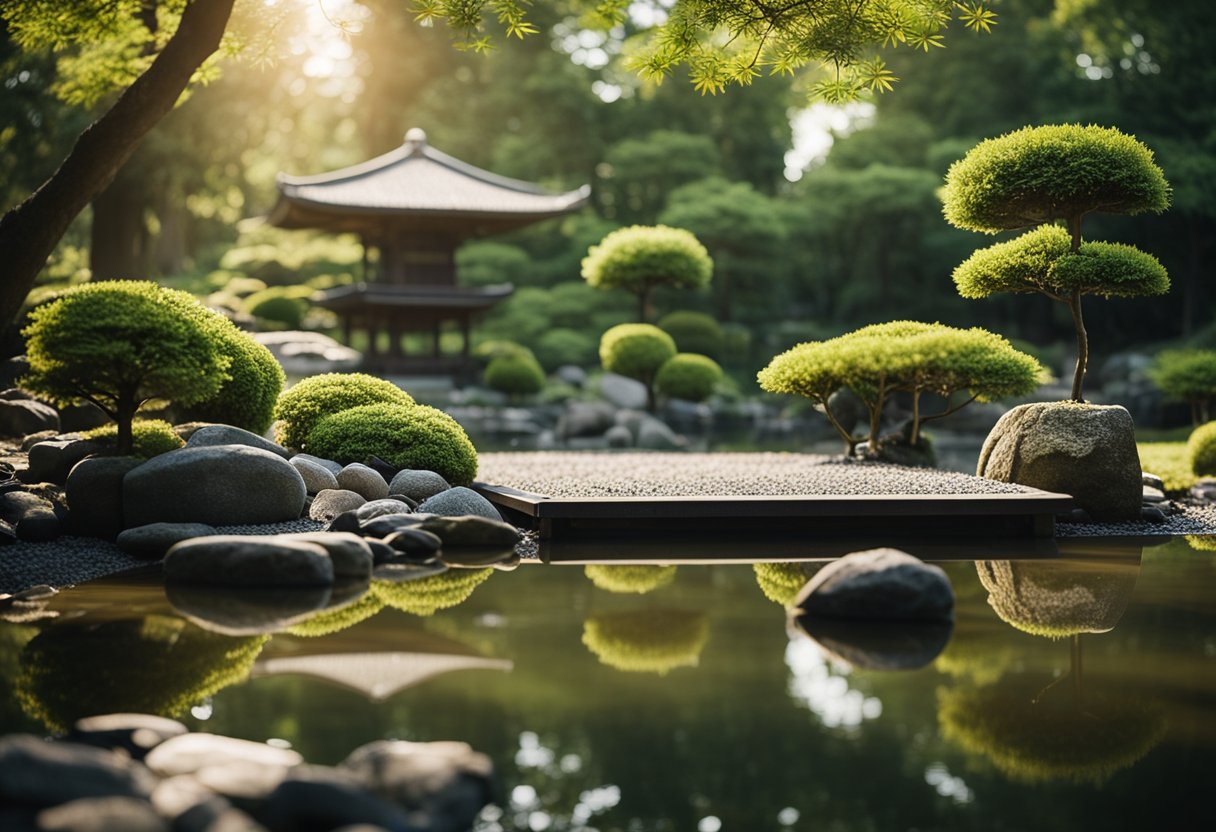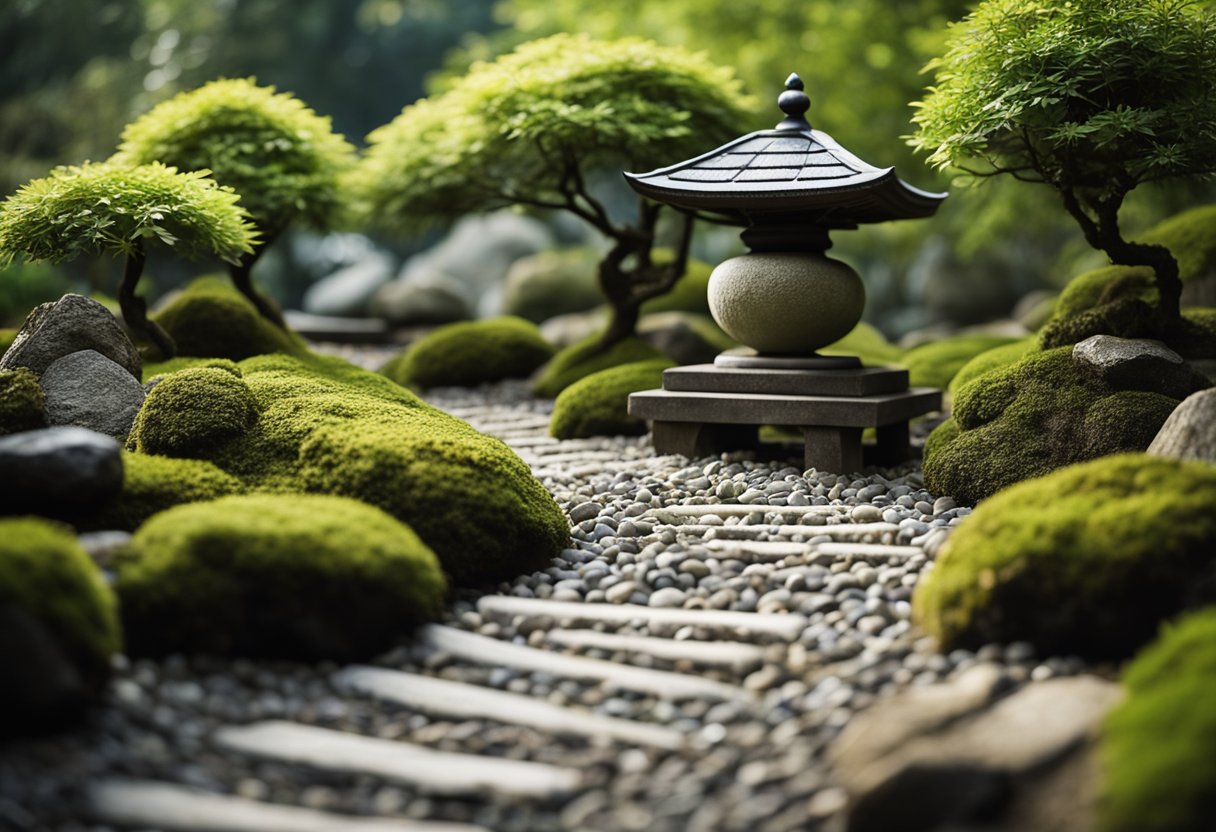Japanese Zen Gardens: Unveiling Serene Beauty and Mindfulness

Updated On: April 24, 2024 by Marwa Alaa
In the bustling flow of modern life, Japanese Zen gardens stand as serene havens of quietude and introspection. Revered for their minimalist beauty and meditative spaces, these gardens are not just landscapes but art forms that embody the principles of Zen Buddhism. They offer a physical expression of the concepts of simplicity, harmony, and the impermanence of life. Through careful placement of rocks, gravel, and small patches of moss and foliage, Zen gardens capture the essence of nature and provide a space for reflection and escape from the outside world.
Crafting a Zen garden is an exercise in spiritual and philosophical thought, reflecting centuries of history and evolution. Each element plays a significant role, from the karesansui, or dry landscape, which uses gravel raked into patterns suggesting flowing water, to the deliberate positioning of stones representing mountains or islands. These elements are carefully chosen and arranged to promote a sense of inner peace and to facilitate meditation. The interaction with a Zen garden is intended to be a deeply personal experience, allowing for a momentary pause, deep breathing, and a step back from daily stressors.
Concepts of Zen Buddhism
Zen Buddhism emphasises direct experiences and personal enlightenment rather than theoretical knowledge or dogma. This tradition plays a vital role in the design and purpose of Zen gardens, where simplicity and naturalness facilitate meditation and self-reflection.
Key Principles:
- Mindfulness: Being fully present in the moment.
- Inner Peace: Cultivating tranquillity of the mind and heart.
- Impermanence: Acknowledging the transient nature of life.
- Wabi-sabi: Appreciating beauty in imperfection and transience.
Zen Philosophy in gardens is evident during the Muromachi Period, with gardens embodying the aesthetics of ‘wabi-sabi’, embracing the imperfect and transient.
Symbolism in these gardens is profound: rocks can represent mountains or islands, raked gravel depicts water ripples or emptiness, and overall minimalism evokes emptiness and invites contemplation. The practices of meditation and contemplation within these spaces align with the Zen Buddhist pursuit of enlightenment.
Samurai warriors of ancient Japan found value in Zen’s teachings, utilising the concepts to maintain composure and focus, revealing the deep intertwining of Zen with multiple facets of Japanese culture.
Zen Gardens are more than aesthetic spaces; they are physical manifestations of the philosophy, intended for quiet contemplation to achieve inner peace and wisdom, embodying the here and now. Through Zen gardens, we connect intimately with the natural world, engage in deep self-reflection, and embrace the teachings of Zen Buddhism in our quest for serenity.
History and Evolution of Japanese Zen Gardens

Japanese Zen gardens represent a pinnacle of harmony and meticulous care, grounding their aesthetics in spiritual practice and cultural exchange. Their evolution traces the influence of Chinese Zen and the distinct transformation within the Japanese cultural context, culminating in several key historical periods.
Influence from China
Zen Buddhism, the foundation of these tranquil gardens, travelled from China to Japan in the 7th century. Chinese teachings greatly influenced the early development of Japanese Zen gardens, using rocks and sand to mimic the natural world and facilitate meditation by Buddhist monks. Over time, these contemplative spaces became integral to Japan’s cultural identity, reflecting the symbiotic relationship between the two nations.
Development in Japan
As Zen Buddhism took root in Japan, the gardens adopted unique Japanese elements, departing from the more rigid Chinese prototypes. By the 11th century, Japanese Zen gardens had become distinctly Japanese, capturing the essence of local aesthetic values and philosophical principles. They served as microcosms of the natural landscape, reducing nature to its bare elements and offering a place for self-reflection and spiritual connection.
The Muromachi Period
The Muromachi period (1336 to 1573) was when Japanese Zen gardens truly flourished. Gardens were further simplified and stylized during this era, embodying wabi-sabi, the beauty of imperfection and transience. Influential gardens like Ryoan-ji, characterised by their karesansui (dry landscape) style, emerged, setting standards for beauty and minimalism that profoundly shaped Japanese culture and garden design for centuries to come.
Design Principles
In creating Japanese Zen gardens, we consider the principles of simplicity and asymmetry, balance and harmony, and symbolism and abstraction of paramount importance. These elements serve to evoke a sense of peace and thoughtfulness.
Simplicity and Asymmetry
We value simplicity (Kanso) as an essential principle, focusing on the reduction and careful selection of elements, which results in a tranquil space that encourages contemplation. To achieve this, we embrace the practice of asymmetry (Fukinsei), which aligns with the natural world where perfect symmetry is uncommon. Our gardens often employ odd numbers of objects, which help to create a more natural appearance.
Balance and Harmony
Although closely related to symmetry, the principle of balance does not necessitate it. Rather, we achieve a sense of equilibrium through thoughtful placement and proportion of garden elements. This relates to harmony (Wa), where each element complements others to represent natural landscapes. The Japanese spatial concept of ‘ma’ plays a vital role here; it represents the space between elements, which is as carefully considered as the elements themselves.
Symbolism and Abstraction
In our gardens, physical elements like rocks, gravel, and water features are not just aesthetic; they are symbolic representations of natural landscapes and larger ideas. Using abstraction, we distil nature into a minimalist art form, allowing for meditation and reflection. We can convey broader concepts such as mountains, rivers, or even the sea through symbolism while offering visitors a deeper narrative.
Elements of the Japanese Zen Garden
In a Japanese Zen Garden, every element is chosen with intention and placed with precision to achieve harmony and balance.
Rocks and Gravel
Rocks are the bones of a Japanese Zen garden, chosen for their shape, colour, and texture. We carefully position them to represent natural formations, often creating miniature landscapes that embody mountains’ rugged beauty or islands’ solitude. Gravel and sand are spread around these rock formations, raked into patterns representing ripples in water or the undulations of a dry landscape. This act of raking is meditative, promoting concentration and mindfulness.
Water Features and Ponds
Water signifies purity, calm, and fluidity in our garden designs. Features such as ponds introduce a reflective surface, mirroring the dynamic changes of the sky above. Islands within these ponds may signify a mystical place accessible only through mental and spiritual avenues. The sound and movement of water imbue a natural flow into these secluded spaces, whether through the gentle trickle of a bamboo water spout or the serene expanse of a still pond.
Plants and Trees
Plants and trees are selected for their ability to enhance the garden’s tranquillity while also representing nature’s impermanence through the changing seasons. Moss, an evergreen presence, blankets the ground with a soft, quiet texture. Trees are often pruned in niwaki style, contributing shade and sculptural form. Their leaves whisper with the wind, while blossoms and autumn colours remind us of the fleeting nature of life. Balancing evergreens with deciduous varieties enriches the landscape with a continuous yet ever-changing tapestry.
Key Aesthetic Concepts
In Japanese Zen gardens, tranquillity and beauty are conveyed through several distinctive design principles. Each contributes to the garden’s serene ambience and reflects deep philosophical ideas.
Ma and Negative Space
Ma refers to the intentional use of negative space in garden design, which promotes a sense of tranquillity through emptiness. This concept allows for reflection and underscores the importance of the void as much as the physical elements within the garden. We see this as gaps between rocks or areas of raked gravel, encouraging moments of pause and contemplation for the viewer.
Wabi-Sabi and Imperfection
The acceptance of transience and imperfection is captured in the principle of wabi-sabi. This concept finds beauty in the imperfect and the impermanent, such as unevenly placed stones or the natural asymmetry in tree growth. It acknowledges that a unique form of beauty in the heart of imperfection lies, leading to a deeper harmony within the garden’s confines.
Shakkei and Borrowed Scenery
Shakkei, or borrowed scenery, involves incorporating the surrounding landscape into the design of the Zen garden. Elements beyond the garden, such as distant mountains or trees, are framed within the garden’s vista, creating a sense of unity with nature. This blending extends the garden into the infinite, encouraging a connection between the man-made and the natural world.
Zen Garden Varieties
Japanese Zen gardens, with their rich tradition and aesthetic philosophy, come in several distinct styles, each offering a unique way to experience the serene beauty of nature. We’ll explore the three main types: Karesansui dry gardens, Tsukiyama hill gardens, and Chaniwa tea gardens.
Karesansui Dry Gardens
Karesansui, or Japanese rock gardens, epitomise the minimalist aesthetics of Zen Buddhism. These dry landscapes utilise rocks, white sand, and gravel to symbolise water elements, creating a stark and meditative environment that encourages reflection and tranquillity. Natural materials are carefully selected and arranged to represent miniature scenes of nature’s grandeur, often resembling islands or mountains amidst a sea of rippled sand.
Perhaps the most famous example of a karesansui garden is Ryoan-ji in Kyoto, a masterpiece of this style. Explore an understanding of Karesansui gardens to appreciate their profound simplicity and underlying philosophy.
Tsukiyama Hill Gardens
Tsukiyama refers to the artificial hills that are the focal points of these gardens, creating a three-dimensional effect and a sense of depth. Incorporating varied elevation changes, these gardens often include ponds, streams, and mountains in miniature form. They are designed to be walked around and viewed from various angles, offering shifting perspectives that echo the experience of walking through natural landscapes.
This garden style is designed to embody the natural beauty of the Japanese countryside, bringing to life the rolling hillsides and scenic vistas in a compact, contemplative space. Visit insights on Tsukiyama gardens for a deeper look into their design and function.
Chaniwa Tea Gardens
Chaniwa gardens are built for the traditional Japanese tea ceremony, a ritual central to Japanese culture. These gardens are distinguished by their tea houses and the roji, or dewy path, which leads guests through a sequence of carefully curated views and landscapes. The path is an integral component designed to transition the visitor from the physical world into the spiritual realm of the tea ceremony.
Water elements, stone lanterns, and stepping stones create a path that invites introspection and a deep connection with the surrounding natural environment. To explore the Chaniwa, a garden that harmonises the spiritual and natural worlds, consider reading about the Chaniwa gardens.
Cultural Significance

Japanese Zen gardens manifest Zen philosophy, often reflecting a profound cultural significance encompassing various aspects of Japanese art, literature, and modern architecture. They serve as areas for contemplation and meditation and as influential forms of artistic expression.
Influence on Japanese Art
Japanese Zen gardens have deeply influenced Japanese art, where the principles of simplicity, asymmetry, and naturalness are revered. The use of space and minimalist aesthetics in these gardens can be seen mirrored in traditional ink-wash paintings, which often evoke the same sense of stillness and reflection. Gardens often use specifically chosen rocks and gravel to represent natural landscapes, illustrating the art of imitating the essence of nature rather than its direct appearance.
Zen Gardens in Literature
Zen gardens have permeated Japanese literature, frequently depicted as settings for poetry and stories that revolve around Zen philosophy and the pursuit of inner peace. In haiku and other forms of Japanese poetry, references to elements of gardens, such as the karesansui or the carefully raked sand, symbolise broader themes of impermanence and the cyclical nature of life.
Impact on Modern Architecture
In modern architecture, the influence of Japanese Zen gardens is evident in the emphasis on blending indoor and outdoor spaces, creating harmony with nature. Architects often draw on the principles of Zen gardens to establish an atmosphere of tranquillity and to incorporate natural materials, lines, and light in their designs. Open spaces and fluid transitions in buildings reflect the same principles that govern these peaceful garden landscapes.
The cultural significance of Japanese Zen gardens cannot be underestimated; they are steeped in a tradition that permeates much of Japanese culture, from art and literature to contemporary architecture. Their principles of meditation, reflection, and stillness continue to resonate and find new expressions in our modern world.
Gardening Practices and Maintenance
In creating a Japanese Zen garden, meticulous gardening practices and consistent maintenance are vital to preserving their meditative ambience and aesthetic appeal. Our dedication to these practices ensures the garden remains a tranquil retreat throughout the changing seasons.
Raking and Tending
Raking the gravel in a Zen garden is a practice of self-discipline and an essential aspect of landscape design. Raking patterns in the gravel symbolise water ripples and promote concentration and mindfulness. The act is not arbitrary; it follows precise strokes to create uniformity and flow. Tending to the garden involves carefully pruning plants maintaining the simplicity and neatness that embody Zen philosophy.
Seasonal Adjustments
Climatic changes call for seasonal adjustments in a Zen garden to uphold harmony in the landscape. We may gently sweep fallen cherry blossoms in spring to maintain the gravel’s pristine appearance. During autumn, leaves are regularly removed, while moss and evergreens may need protection or exposure adjustments depending on winter conditions.
Purification Rituals
Purification plays a role in the Zen garden, reflecting Zen Buddhism’s purity of thought and action. Regularly cleansing garden elements, such as rocks and water features, is part of our meticulous care. This sustains the garden’s physical cleanliness and spiritual significance, providing a sanctified space for contemplation.
Experience and Interaction
In Japanese Zen Gardens, the elements are meticulously placed to foster deep contemplation and serenity within one’s inner self. Here, we’ll explore how pathways, bridges, and secluded viewpoints are integral to these gardens’ meditative experience.
Pathways and Bridges
In our journey through these tranquil spaces, we encounter pathways and bridges — each thoughtfully designed to direct our steps and thoughts. The meandering paths invite us to slow down and absorb the surroundings, mirroring the winding journey to mindfulness. The bridges we cross, often simple in structure, serve as a physical and symbolic passageway to heightened states of reflection.
Viewpoints and Seclusion
Positioned throughout the garden, viewpoints are carefully crafted to offer moments of seclusion. Here, we can sit and gaze upon the garden, contemplating the harmony between nature and artistic interpretation. These spots are invitations to pause and meditate, allowing the mind to wander and explore the depths of tranquillity.
Mindful Observation
As we engage in mindful observation, we focus on the subtle interplay of light, shadow, and various textures within the garden. This observation becomes a mindfulness practice, grounding us in the present moment. Witnessing the details of a Zen garden helps cultivate a deep connection with our inner self, fostering a sense of peace and calm.
Modern Zen Gardens
Modern Zen Gardens have taken centre stage with their transformative tranquillity and minimalist aesthetic in the ever-evolving garden design landscape.
Adaptations in Western Settings
As Zen gardens have travelled beyond their Japanese origins, we’ve seen a thoughtful integration of their core design principles within Western settings. This adaptation respects the original intent of crafting meditative spaces while incorporating elements that resonate with local cultural sensibilities. In our homes and communal landscapes, these gardens provide a sanctuary from bustling modern life, inviting calmness through their serene compositions of rocks, water features, and carefully curated vegetation.
Zen Gardens in Public Spaces
We’ve witnessed the emergence of Zen gardens in public spaces, where they function as tranquil oases amid urban environments. Cities across the globe are embracing these gardens as part of their green infrastructure, offering inhabitants and travellers alike a place to pause and reflect. The design of these spaces often encourages interaction, whether through meandering pathways or strategically placed seating that allows for contemplation amidst nature.
Indoor and Miniature Versions
Indoor and miniature Zen gardens epitomise Zen garden adaptation within limited space constraints. These smaller versions are finding homes on desks, in living rooms, and even in areas of commercial spaces. They embody the Zen principle of simplicity, using minimal elements like sand, pebbles, and small plants to create a representation of the natural world. Such indoor gardens complement the interior design and act as a tool for mindfulness and stress relief.
Philosophical and Spiritual Resonance
Our exploration of Japanese Zen gardens shows that these tranquil spaces are steeped in Zen Buddhism’s philosophical and spiritual practices. These gardens are physical representations of Zen philosophy and conduits for the teachings of emptiness and mindfulness.
Emptiness, in the context of Zen, doesn’t denote a lack of something but rather the potential for all possibilities. It is reflected in the open spaces and minimalistic design of Zen gardens, where simplicity is paramount. Through their careful composition, these gardens invite contemplation and meditation, guiding us to recognise the impermanence and interdependence of all things.
Mindfulness is intrinsic to the Zen garden experience. With every stone meticulously placed and each rake mark thoughtfully curved, the garden becomes a medium for cultivating awareness and presence. We self-reflect, attuning ourselves to the subtle changes in the environment and our internal landscape.
The serenity of a Zen garden often leads to an experience of inner peace. This tranquillity is deliberate, creating a space for deep meditation, often paving the path to enlightenment. Within the bounded walls of these gardens, the chaos of the outside world falls away, allowing us to connect with our inner selves on a profound level.
Moreover, the Zen principle of unity and harmony encourages us to reflect on our connection to the natural world. The meticulous care and attention to detail in these gardens echo our inner workings—the more harmonious our internal state, the more peaceful our outward expression.
Japanese Zen gardens’ philosophical and spiritual resonance manifests Zen’s core principles. They stand as serene havens for meditation, mindfulness, and the pursuit of enlightenment, embodying a physical space for profound spiritual growth and introspection.

FAQs
In this section, we address some common queries about the serenity and design of Japanese Zen gardens and their deep connection with Zen Buddhism.
What elements constitute a traditional Japanese Zen garden?
A traditional Japanese Zen garden typically features key elements such as rocks, gravel, moss, and sometimes water or pruned plants. These components are meticulously arranged to represent natural landscapes in a minimalist way. Tranquillity is evoked through these symbolic elements, inviting contemplation and reflection.
How does one maintain a sense of tranquillity in a Zen garden?
Maintaining tranquillity in a Zen garden is achieved by upholding simplicity and harmony in its design. This encompasses the careful placement of rocks and the raking of gravel to provoke a sense of calmness and serenity. Regular upkeep of the garden helps to preserve its peaceful atmosphere and aesthetic purity.
What role does karesansui play in the design of Zen gardens?
Karesansui, or “dry landscape” gardens, play a crucial role in Zen gardens by embodying nature’s essence without water. This technique utilises rocks and gravel to symbolise mountains, islands, and flowing rivers, creating a meditative space for Zen practice.
How do the seasons affect the aesthetics of Japanese Zen gardens?
The aesthetics of Japanese Zen gardens are influenced by the changing seasons, each bringing a unique transformation. The fresh green of moss in spring, the vibrant colours in autumn, and the stark beauty of snow in winter all contribute to the garden’s seasonal beauty, reflecting the ephemeral nature of life.
In what ways do Zen gardens reflect the principles of Zen Buddhism?
Zen gardens are physical representations of the principles of Zen Buddhism, emphasising mindfulness, simplicity, and the beauty of imperfection or “wabi-sabi.” The minimalist design encourages visitors to let go of unnecessary thoughts and focus on the present moment.
What distinguishes a Zen garden from other types of Japanese gardens?
Zen gardens are distinguished by their minimalistic design and spiritual purpose, which contrast to other Japanese gardens, which may focus more on recreation and aesthetics. The primary intention of Zen gardens is to aid in meditation and bring one closer to enlightenment rather than simply being spaces of natural beauty.






